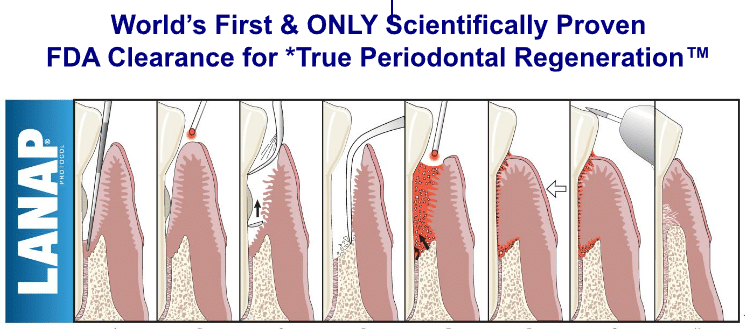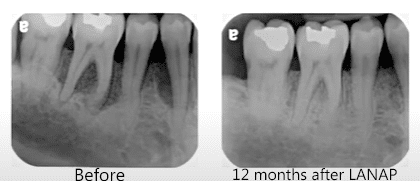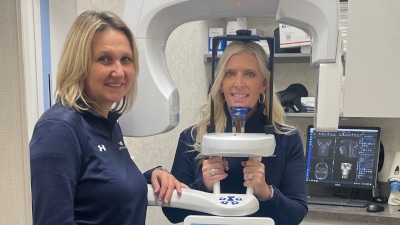It’s scary when the dentist tells you that you have gum disease.
One hundred questions run through your mind. What is gum disease? How bad can it get? Can gum disease be treated? What is the best gum disease treatment? Am I going to lose my teeth? When you’re that anxious, it’s hard to figure out next steps.
Gum disease isn’t something you can sweep under the rug, but a little understanding can make you feel much better.
Here’s where we’re going:
- What is gum disease?
- What is osseous surgery?
- What is LANAP?
Take a breath and let’s get some answers.
What is gum disease?
Though fairly common, gum disease or periodontitis is a serious gum infection. It damages the soft tissue, and if left untreated, it can destroy the bone that supports your teeth. With damaged gums and bone, teeth can loosen or be lost altogether.
What causes gum disease?
Gum Disease, or “Periodontitis” starts with plaque — a sticky film over your teeth full of bacteria.
A number of risk factors can turn excess plaque into gingivitis and eventually gum disease:
- Diabetes & other illnesses that interfere with the immune system
- Hormonal changes
- Uneven biting forces from grinding and clenching
- Medications that reduce saliva
- Smoking or chewing tobacco
- Poor oral hygiene habits
- Family history of dental disease
Symptoms of gum disease
Gum disease may progress for a while before it is noticed. The main symptoms include one or many of the following:
- Red or swollen gums
- Bleeding gums
- Receding gums
- Painful chewing
- Persistent bad breath or bad taste in the mouth
- Receding gums
- Formation of deep pockets between teeth and gums
- Loose or shifting teeth
- Change in the way teeth fit together
What is osseous surgery?
Because gum disease can lead to tooth loss and other health issues, a dentist will likely recommend treatment as soon as possible. One of the most common treatments they’ll recommend is called osseous surgery. Osseous surgery is a more traditional resective procedure of cutting the gum away and reshaping the bone around the teeth
What happens during osseous surgery?
- During surgery the dentist will make incisions around the teeth and fold the gums back.
- They will then clean the area and remove bacteria.
- It’s likely they’ll need to use hand tools to cut and shape the bones around the teeth. If the bone is severely infected, they may need a bone graft to help maintain the shape and structure of the jaw.
- Once the infected tissue is removed, the gums will be pulled back over the bone and sutured together. The area will then be bandaged to heal.
What are the downsides to osseous surgery?
Reading that description may cause you to recoil. After all, it sounds pretty barbaric. The surgery could make anyone nervous, but if you have dental anxiety it’s the last thing you want to hear. Osseous surgery is such an invasive procedure, you need a sizable time to recover.
After surgery, you’ll need pain medications for about two weeks. Your mouth will be heavily bandaged and it will take around four weeks to fully recover.
After you get your stitches removed you’ll still have to cope with some challenges. The gums may bleed and you’ll have to change your gauze regularly. Patients will want to rinse their mouth with saltwater each day and will need an ice pack to manage swelling. Plus, you’ll be unable to use a straw and limited to soft foods for at least a few days.
After a successful surgery, you’ll have cleaner teeth and healthier gums. However, the teeth will likely have a longer appearance with roots exposed. If gum disease continues, you may need to have surgery again, each time cutting away more of the gums.
What is LANAP?
If gum surgery makes you nervous, you’ll be glad to know there’s a laser alternative to osseous surgery.
LANAP or Laser Assisted New Attachment Procedure is an FDA-approved, cutting-edge treatment for gum disease. It is both less painful and more successful than osseous surgery.
In LANAP there is no cutting or sewing of the gums. Instead, the treatment uses a special laser to clean the infection and remove plaque. The laser is just light energy and it’s so thin it’s hardly noticeable as it’s swept under the gumline.

This kills bacteria and reduces inflammation without removing any healthy gum tissue. The procedure helps tissue heal safely and rapidly. It seals the gum pocket to allow for bone regeneration.
What are the benefits of LANAP?
As you may have guessed, increased comfort is a major benefit of LANAP. Compared with the pain of osseous surgery, LANAP is minimally invasive.
Recovery is also much faster. After surgery, most patients can just take a couple of ibuprofen and return to work by the next day.
Unlike osseous surgery, LANAP is regenerative. It actually lets bone grow back. Your mouth becomes healthier instead of just getting rid of more and more of the gums.
And since LANAP doesn’t cut out the gums, it has better-looking results too. After osseous surgery, the gums are cut lower so teeth look longer and feel more sensitive. LANAP maintains the gum height so your smile looks good and hurts less.
Does LANAP work?
If you’re considering gum disease treatments, the idea of more comfort and less recovery time probably has you intrigued with LANAP.
But does the procedure work?
The answer is a resounding yes.
LANAP has been shown to result in less tooth loss compared to traditional surgery. It also increases new tissue attachment and aids in gum and bone regeneration.
And the benefits continue in the long-term.

LANAP patients have less recurrence of periodontal disease over time. That means no future surgery! Because the healing is faster and less painful, patients find it easier to keep up with the care regimens needed to keep gum disease at bay.
How do you get LANAP?
You probably haven’t heard much about LANAP because it is a newer procedure that requires advanced training to perform.
Its outcomes have been scientifically validated, but most dentists lack the expertise and equipment needed for LANAP.
Main Takeaways for Gum Disease Treatments
Clear up your fears about gum disease treatments knowing LANAP may be a better alternative to traditional osseous surgery.
Here are the things you want to remember:
- Gum disease is too important to ignore
- Osseous surgery isn’t your only treatment option
- LANAP promises a more comfortable treatment for gum disease
- LANAP is more effective and has an easier recovery
- You can call Lake Forest Smiles to get all of your LANAP questions answered
Gum disease might sound scary, but with this information you can take heart — it doesn’t have to keep you from smiling.












